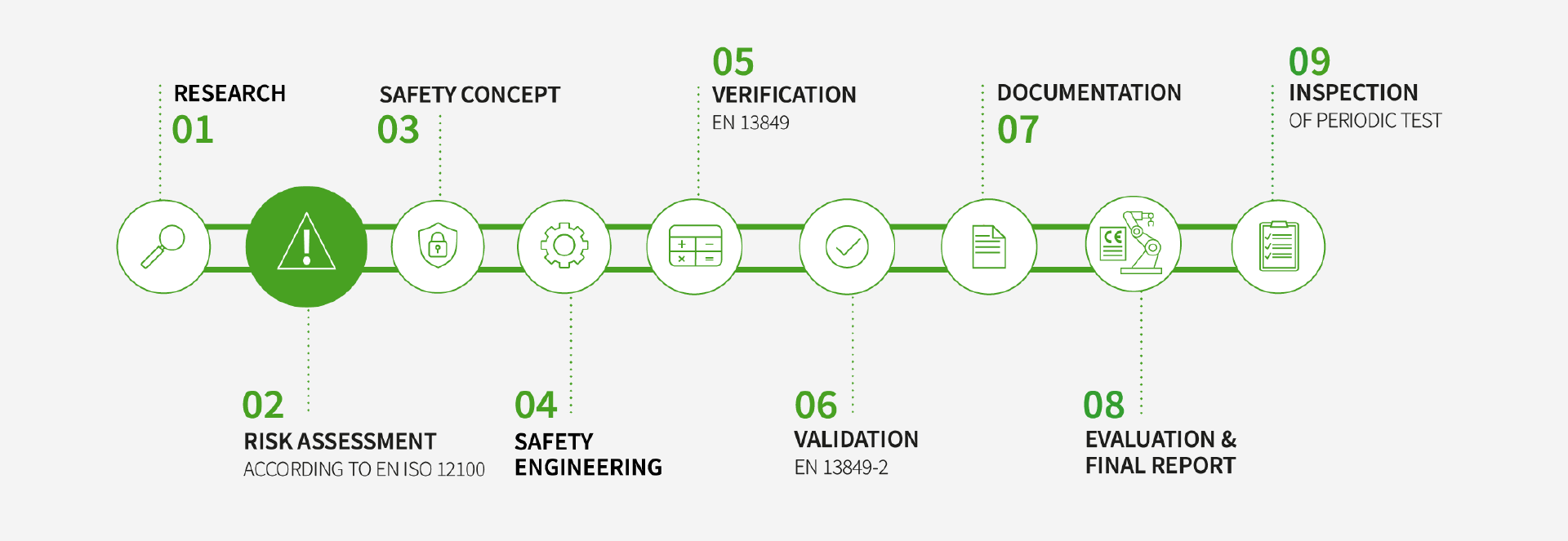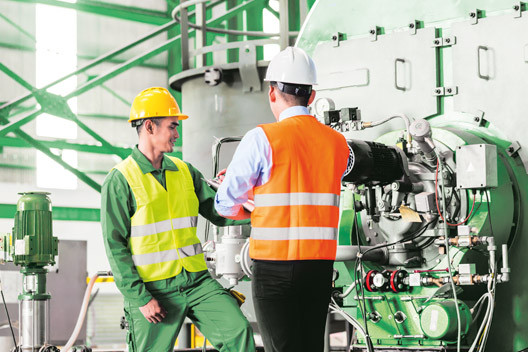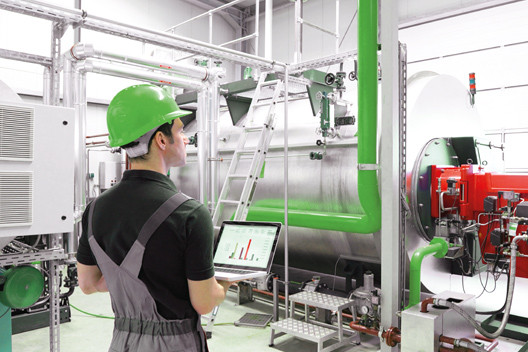
• 01 Research ▸ 02 Risk Assessment • 03 Safety Concept • 04 Safety Engineering • 05 Verification
• 06 Validation • 07 Documentation • 08 Evaluation & Final Report • 09 Inspection
02 RISK ASSESSMENT –
THE FOUNDATION FOR SAFETY AND COMPLIANCE
Risk assessment is a critical step in the CE process, where all potential hazards associated with a machine are systematically analyzed and evaluated. Risks are identified, prioritized, and corresponding mitigation measures are defined. This step lays the groundwork for developing a standards-compliant safety concept and ensures the long-term safety and efficiency of your machine.
With Wieland at your side, you can be confident that this process is carried out precisely and thoroughly.

Goal:
Identify, assess, and document all potential hazards related to the machine in accordance with EN ISO 12100. This forms the basis for the development of a compliant safety concept.
Description:
This step involves identifying all hazards that may occur throughout the entire machine lifecycle – from assembly and operation to maintenance. Based on this analysis, mitigation measures are defined to reduce risks to an acceptable level. The results directly influence machine design and the safety concept.
- Designers/Engineers: Responsible for the technical implementation of safety measures.
- Safety Engineers: Carry out the risk assessment and define risk reduction measures.
- CE Coordinators: Integrate the risk assessment into the CE process and ensure compliance with applicable standards.
Target Audience:
⚙️ CHALLENGES & COMMON ISSUES
- Complexity of Hazard Analysis:
Many companies struggle to systematically identify all relevant hazards and fully meet the requirements of EN ISO 12100. Critical hazards—especially those across different machine lifecycle phases—are often overlooked.
- Uncertainty in Risk Evaluation:
Assessing risks using the principle “Risk = Severity × Frequency × Possibility of Avoidance” requires solid expertise. Lack of experience may lead to misjudgments and insufficient protective measures.
- Incomplete Documentation:
The results of the risk assessment, including defined mitigation measures, are often not fully documented. This can lead to delays or rework later in the CE process, as this documentation is a key part of the CE Declaration of Conformity.
🔧 HOW WE SUPPORT YOU
- Detailed Risk Analysis:
We identify and assess hazards, and work with you to define effective risk reduction measures.
- EN ISO 12100 Training:
We train your team on the requirements of the standard and provide hands-on knowledge for practical risk assessment.
Need support with this step?
Our experts are always here to support you with practical assistance
Contact usCONSULTING SERVICES
Expertise on demand – for a safe and compliant future.
Services | Audience | Description | |
|---|---|---|---|
| Machine safety consultation day on-site | Manufacturers and Operators | Our experts visit your site and provide advice on optimizing the safety of your machines and facilities to ensure safe and reliable production. | Learn more |
| Risk assessment of machinery according to DIN EN ISO 12100 | Manufacturers and Operators | Conducting a risk assessment according to DIN EN ISO 12100 provides an overview of the risks of your machines and enables targeted measures to be taken to reduce these risks. | Learn more |
| Effects of substantial modifications to machinery for CE marking | Operators | We regularly check your machines for significant changes to ensure that they continue to meet applicable safety standards and do not affect your operational processes. | Learn More |
| Hazard and risk analysis of machinery for operators | Operators | Our comprehensive risk assessment provides valuable recommendations for improving the safety of your machines and reducing the risk of accidents. | Learn more |
Consulting that creates safety – Discover our full range!
View all consulting servicesTRAININGS
Strengthen your independence and build long-term expertise.
Course | Description | Certification | |
| Certified Electrical Safety Engineer | The 3-day course focuses on the electrical section, providing you with a complete overview of the CE process with a final examination for TÜV certification. | ✅ TÜV-certified | Learn more |
| Refresher Seminar – Certified Safety Engineer | Our course offers you the opportunity to renew your certification and be well-prepared for the future. | ✅ TÜV-certified | Learn more |
| Certified Functional Safety Expert (CFSE) for Electrical and Fluid Power Systems | Comprehensive training for electrical & fluid safety systems. | ✅ International certification | Learn more |
| Fundamentals of functional safety | The course provides legal and normative foundations for assessing the functional safety of a machine. | ✅ Wieland Training certificate | Learn more |
| Retrofit of used machinery and the significant modification | In this course, you will learn how to carry out the conversion of old machines in the existing machine park. | ✅ Wieland Training certificate | Learn more |
Training for your expertise – deepen your knowledge now!
View all training coursesDOWNLOADS
PRACTICAL MANUAL
FOR FUNCTIONAL SAFETY
Experience knowledge at your fingertips. Our functional safety practical handbook offers simple guidance and easy-to-understand examples for designing safety solutions. Experienced practitioners and standards experts provide a comprehensive insight into the most important topics relating to functional safety. Application examples of safety circuits and Sistema calculations help maintain the longevity of your machine’s operating lifecycle.

YOUR ORIENTATION
IN THE CE PROCESS
You are currently at Step 02: Risk Assessment.
Building on the research, this is the next key step to analyze hazards and systematically assess risks. This phase is essential for developing a safety concept and ensuring your machine is implemented in compliance with applicable standards.
To keep an overview of the entire CE process, you’ll find the summary here:


01 Research
Identify all applicable standards, directives, and legal requirements for your machine type – the foundation for a legally secure and smooth CE process.

02 Risk Assessment
Evaluate all potential hazards throughout the machine’s lifecycle according to EN ISO 12100 and lay the groundwork for a sound safety concept.

04 Safety Engineering
Bring your safety concept to life with well-designed technology and develop standards-compliant safety software – for a safe and productive machine.

03 Safety Concept
Derive specific protective measures based on the risk assessment – compliant with EN ISO 13849-1 and tailored to your operational needs.

05 Verification
Verify the implementation of protective measures in line with EN ISO 13849-1 – especially with regard to the required performance level.

07 Documentation
Ensure that all records – from risk assessment to validation – are complete, consistent, and CE-compliant.

09 Inspection
Conduct regular inspections to ensure the functionality of your safety measures throughout the machine’s entire lifecycle.

06 Validation
Test directly on the machine whether all technical safety measures function reliably and meet the specified requirements.

08 Evaluation & Final Report
Compile and confirm all relevant evidence in a final report – forming the basis for the Declaration of Conformity.